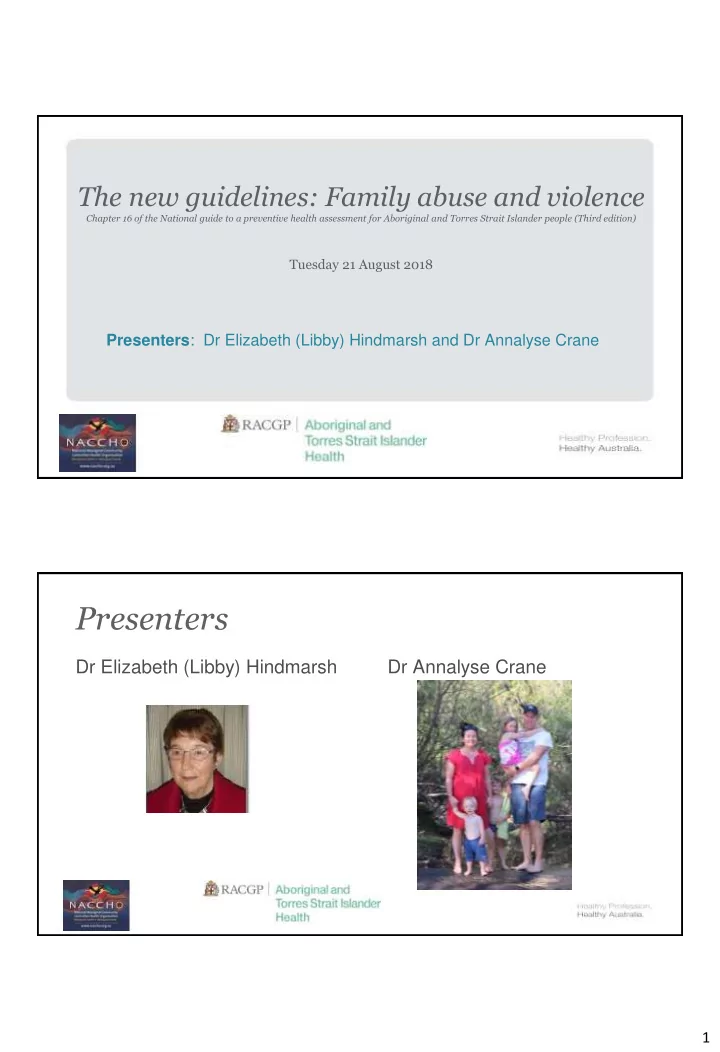

The new guidelines: Family abuse and violence Chapter 16 of the National guide to a preventive health assessment for Aboriginal and Torres Strait Islander people (Third edition) Tuesday 21 August 2018 Presenters : Dr Elizabeth (Libby) Hindmarsh and Dr Annalyse Crane Presenters Dr Elizabeth (Libby) Hindmarsh Dr Annalyse Crane 1
Acknowledgement of Country The RACGP would like to acknowledge the traditional owners of the lands on which this webinar is being broadcast and we pay our respects to the elders, past and present. call 1800 194 319 for webinar technical assistance Learning outcomes • Identify family abuse and violence by case finding and antenatal screening and other preventative interventions using Chapter 16: Family abuse and violence of the National Guide to a preventive health assessment for Aboriginal and Torres Strait Islander people (National Guide) as a resource. • Outline the role of general practitioners (GPs), Practice Nurses (PN) and Aboriginal Health Workers (AHW) in the context of family abuse and violence (FAV) and Aboriginal and Torres Strait Islander people. • Discuss the barriers to effective implementation of family abuse and violence support services faced by Aboriginal and Torres Strait Islander communities. • Recognise how the National Guide can support best practice preventive healthcare for Aboriginal and Torres Strait Islander people. 2
Review of the chapter • Background • Identification • Interventions • Recommendations • Resources Background • Family abuse and violence (FAV) is the term used in this chapter and covers victims, perpetrators and children • Aboriginal and Torres Strait Islander women are x34 times more likely to be hospitalised • FAV is the greatest driver for Aboriginal and Torres Strait Islander children being in and out of home care • Aboriginal men have high levels of incarceration part of which is due to FAV • The terms used to describe what is happening are often minimise d and excus ive of the abuse and violence 3
Identifying family abuse and violence • Early identification and support • Healthcare providers are likely to be the first professional contact for survivors – so need to have necessary knowledge, skills and resources • If victims present, then it may be with a range of symptoms – depression, anxiety, insomnia, PTSD, nonspecific pain, drug and alcohol and in other ways - the underlying issue however is FAV • Consider the children and requirements for mandatory reporting when their safety cannot be ensured • Perpetrators are also being seen for other medical care and there is an opportunity with training to start to identify these people Interventions • Asking women about FAV – then working with the victims around safety and management (need to say this takes time and is more like treating a chronic illness) • Thinking about the involvement of the whole community • Thinking about the barriers • Screening • Case finding 4
Recommendations • Screening • Behavioural • Environmental Screening and Case finding • Women receiving antenatal care – screen at least once in pregnancy • Victims of FAV - the first aid of FAV is to ask and to address safety • Perpetrators of FAV are presenting to AMS and GP with other medical needs – asking perpetrators about what is happening at home and how conflict is being managed is a skill we need to develop • Having a whole of service or practice discussion about how best to do this, support each other and know the services available in the area. 5
Behavioural • Consider high risk victims – young women, those with a history of substance abuse, marital difficulties and economic hardship • As part of antenatal care (see Chapter 2 Antenatal care) • Perpetrators – work to engage perpetrators in men’s behavioural change groups where available or work towards having these provided • Addressing the use of alcohol and drugs in patients and families (see Chapter 1 – Alcohol and Chapter 4 – Young People) • Healthcare providers need training, support to address FAV and opportunities for support and debriefing when addressing these issues with patients Environmental Programs and interventions that can assist with reduction and management of FAV include: • School based programs for high school and adolescents which teach and promote healthy relationships • Encourage the community to develop women’s support groups, emergency shelter, legal assistance • Support community and government initiatives to reduce alcohol related harm 6
Resources • Chapter 16 National guide to a preventive health assessment for Aboriginal and Torres Strait Islander people (Third edition) https://www.racgp.org.au/your- practice/guidelines/national-guide/ • National Family Violence Prevention Legal Services http://www.nationalfvpls.org/ • 1800RESPECT (1800 737 732) 24 hour/ 7 days a week / national phone line www.1800respect.org.au • RACGP ‘Abuse and violence: working with our patients in general practice’ 4th edition. Chapter 5 Perpetrators / Chapter 6 Child Abuse / Chapter 11 Aboriginal and Torres Strait Islander Communities www.racgp.org.au/whitebook 7
Recommend
More recommend